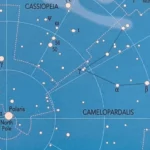Unlock the magic of the Northern Lights in Idaho: Discover the secrets to witnessing this celestial spectacle in the Gem State.
You might picture Alaska or Iceland when you think of the Northern Lights, but did you know Idaho offers a surprisingly good chance to witness this phenomenon? While not as well-known, Idaho’s northern latitude and incredibly dark skies create ideal conditions for catching the aurora borealis. This guide will equip you with everything you need to plan an unforgettable aurora-hunting adventure in the Gem State.
Where to See the Northern Lights in Idaho
The key to seeing the Northern Lights lies in finding dark skies far from city lights. Luckily, Idaho has plenty of those! Here are a few of the top spots:
Northern Idaho:
- Heyburn State Park: Nestled near the Idaho Panhandle National Forest, Heyburn offers expansive views of the night sky with minimal light pollution.
- Priest Lake: Known for its remote location and pristine beauty, Priest Lake is an aurora hunter’s paradise. The lack of light pollution significantly increases your chances of witnessing a vibrant display.
- Idaho Panhandle National Forests: This expansive wilderness area boasts some of the darkest skies in the state, making it ideal for Northern Lights viewing.
Looking for more options? Check out the International Dark-Sky Association website for a map of certified dark sky places in Idaho.
Southern Idaho:
While sightings are less common in southern Idaho, powerful geomagnetic storms can occasionally make it possible to see the aurora even in this part of the state.
When to Go: Timing Your Aurora Adventure
While the aurora can be unpredictable, planning your trip around the right time of year can significantly boost your chances.
- Best Months: September to April, when the nights are longer and darker.
- Time of Night: The aurora is often most active around midnight (between 10 p.m. and 2 a.m.).
Tips for Planning Your Northern Lights Trip to Idaho
- Check the Aurora Forecast: Websites and apps like the NOAA Space Weather Prediction Center provide valuable information about geomagnetic activity, which directly influences the likelihood and intensity of auroras.
- Embrace the Darkness: The further you are from city lights, the better your chances of seeing the aurora. Seek out remote locations with minimal light pollution.
- Dress for the Cold: It can get very cold in Idaho, especially at night during the aurora viewing season. Be sure to dress warmly in layers to stay comfortable.
- Be Patient: Remember, the aurora is a natural phenomenon, which means it’s unpredictable. Some nights offer spectacular shows, while others may have little to no activity. Be patient, enjoy the peace of the night sky, and you might just be rewarded with an incredible display.
- Consider Photography: To capture the beauty of the aurora, bring a camera with manual settings and a tripod to keep your shots steady during those long exposures.
Can you see the northern lights in Sun Valley, Idaho?
While you might think of skiing first, Sun Valley, Idaho, is also a surprisingly good location to see the Northern Lights. Its distance from major cities and relatively dark skies make it a hidden gem for aurora viewing.
The best time to catch the show in Sun Valley is between September and March, when solar activity is typically higher. If you’re in the area during these months, it’s worth taking the time to venture out into the darkness and scan the skies for this celestial wonder.
Where to See the Northern Lights in the USA in 2024
If you’re ready for an aurora-hunting adventure, here are some of the top destinations in the US to consider:
- Fairbanks, Alaska: Known as the “Aurora Capital of the World,” Fairbanks offers incredible viewing opportunities from late August to early April.
- Denali National Park, Alaska: Combine your aurora search with the stunning landscapes of Denali National Park for an unforgettable experience.
- Chena Hot Springs Resort, Alaska: Relax in natural hot springs while you wait for the aurora to appear at this popular resort.
- Aroostook County, Maine: You might be surprised to find Maine on this list, but Aroostook County offers dark skies and a good chance of catching the lights.
Capture the Magic of the Northern Lights
Witnessing the aurora borealis in Idaho is an experience you won’t soon forget. The vibrant colors dancing across the night sky create a sense of awe and wonder that few natural phenomena can match. By following these tips, you can increase your chances of experiencing this magical display firsthand. As a bonus, consider bringing along your atomic rhino smelling salts to keep you alert and invigorated during those late-night aurora hunts.
Remember, a successful aurora hunt requires a bit of luck, but with the right planning and a sense of adventure, you might just find yourself mesmerized by the Northern Lights in the heart of Idaho. And while you’re at it, why not enhance your home environment with the benefits for a Himalayan salt lamp.
- Unlock Water’s Symbolism: A Cross-Cultural Exploration - April 20, 2025
- Identify Black and White Snakes: Venomous or Harmless? - April 20, 2025
- Unlocking Potential: Origins High School’s NYC Story - April 20, 2025















